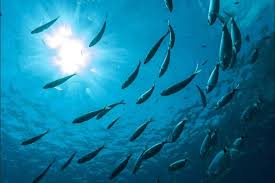India’s First Organic Fisheries Cluster

- 12 Jan 2025
In News:
The Union Minister, Department of Fisheries, Ministry of Fisheries, Animal Husbandry and Dairying Shri Rajiv Ranjan Singh inaugurated and laid the foundation for 50 key projects worth Rs. 50 crores under Pradhan Mantri Matsya Sampada Yojana (PMMSY) covering all North East Region States Except Arunachal Pradesh and Mizoram.
Key Highlights:
- Initiative: India’s first Organic Fisheries Cluster, launched under the Pradhan Mantri Matsya Sampada Yojana (PMMSY). The cluster focuses on sustainable aquaculture, promoting the production of antibiotic, chemical, and pesticide-free organic fish.
- Target Markets: Eco-conscious domestic and global markets.
Sikkim's Role as India’s First Organic State:
- Sikkim's Organic Commitment: Sikkim is the first Indian state to embrace 100% organic farming, covering 75,000 hectares of land.
- Vision: The Organic Fisheries Cluster aligns with Sikkim’s broader goal of promoting organic, sustainable agricultural practices.
Objective of Organic Fisheries Cluster:
- To prevent pollution and protect aquatic ecosystems by using ecologically healthy practices.
- Promotes sustainable fish farming methods, reducing environmental damage.
- Focus on species like amur carp and other carp varieties, aligning with the state’s success in organic farming.
Support from NABARD:
- The National Bank for Agriculture and Rural Development (NABARD) will provide financial and technical assistance.
- Key support includes:
- Infrastructure development.
- Formation of Fisheries-based Farmer Producer Organizations (FFPOs).
- Capacity building of local fishers and farmers.
PMMSY: A Comprehensive Fisheries Development Scheme:
- Investment: ?20,050 crore under PMMSY.
- Objective: To revolutionize India’s fisheries sector by promoting sustainable growth, enhancing fish production, and improving infrastructure.
- Implementation Period: FY 2020-21 to FY 2024-25.
- Key Goals:
- Boosting fish production and exports.
- Enhancing welfare of fishers and farmers.
- Promoting cluster-based development for better efficiency and competitiveness.
Cluster-Based Approach in Fisheries:
- Objective: To bring together geographically connected enterprises to enhance economies of scale.
- Impact: This approach improves financial viability, strengthens the fisheries value chain, and creates new business and livelihood opportunities.
- Types of Clusters: Includes Pearl, Seaweed, Ornamental Fisheries, Cold Water Fisheries, Organic Fisheries, and more.
Fisheries Focus in the North Eastern Region (NER):
- Fisheries Potential: The North Eastern Region (NER) has abundant freshwater resources and is a biodiversity hotspot.
- Growth: Inland fish production in the NER surged from 4.03 lakh tonnes (2014-15) to 6.41 lakh tonnes (2023-24), marking an impressive 5% annual growth.
- Investment in NER: Over ?2,114 crore invested through schemes like Blue Revolution and PMMSY.
- Key Projects:
- 50 projects worth ?50 crore to boost the region’s fisheries infrastructure, generating over 4,500 jobs.
- Projects include hatcheries, cold storage units, aquaculture parks, and fish kiosks.
India’s Global Fisheries Standing:
- India is the second-largest fish producer in the world, contributing 8% to global fish production.
- Top Rankings:
- Second in aquaculture production.
- Leading in shrimp production and exports.
- Third in capture fisheries.
Government Commitments and Schemes:
- Total Investment: Since 2015, the government has committed ?38,572 crore to fisheries development through key schemes like:
- Blue Revolution.
- Fisheries and Aquaculture Infrastructure Development Fund (FIDF).
- PMMSY.
- Pradhan Mantri Matsya Kisan Samridhi Sah-Yojana (PM-MKSSY).
- These initiatives aim to promote sustainable growth, create jobs, and enhance infrastructure in the fisheries sector.
Economic, Environmental, and Social Benefits:
- Economic Impact:
- Higher incomes for fishers and farmers through better production and export.
- Employment generation through infrastructure development.
- Environmental Impact: Reduced pollution and protection of aquatic ecosystems.
- Social Impact: Empowerment of local communities, fostering sustainable livelihoods.
